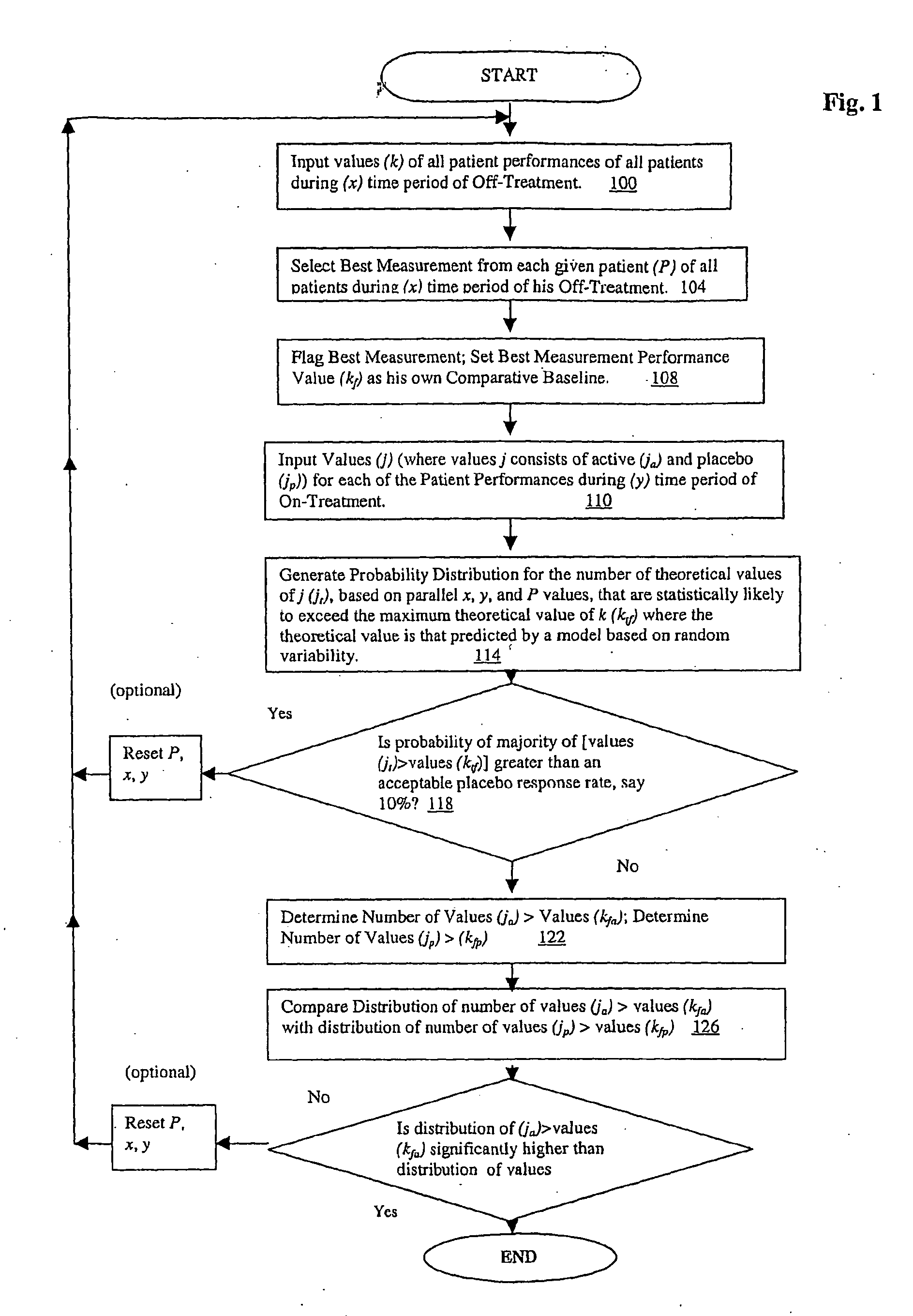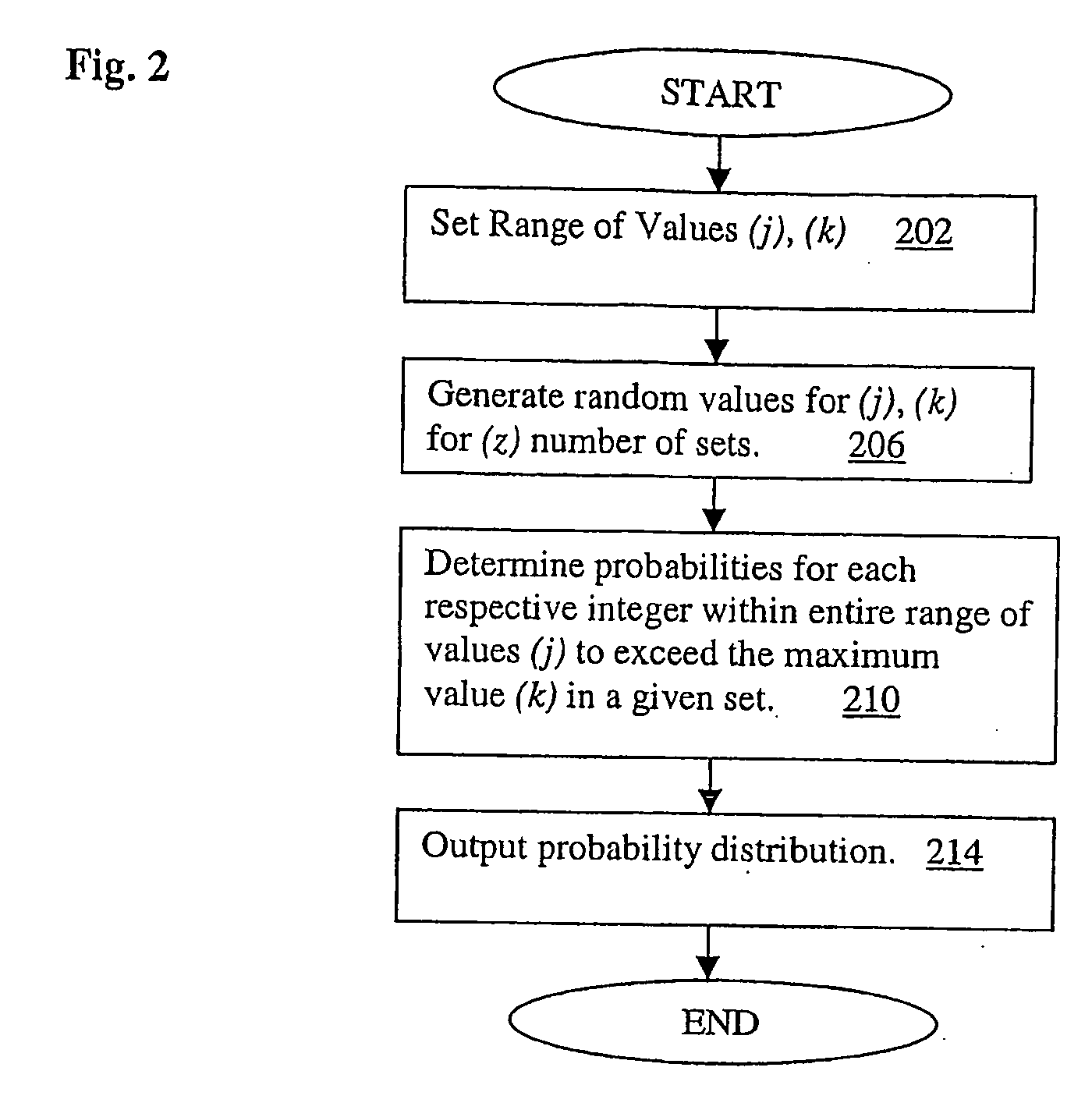Method, apparatus and solftware for identifying responders in clinical environment
a clinical environment and responder technology, applied in the field of clinical environment identifying responders, can solve the problems of spontaneous variability obscuring treatment-related effects, inability to accurately predict or plan future trials, and inability to salvage or otherwise learn from failed clinical trials, etc., to achieve the effect of improving performan
- Summary
- Abstract
- Description
- Claims
- Application Information
AI Technical Summary
Benefits of technology
Problems solved by technology
Method used
Image
Examples
example 1
[0052]Theoretical basis: Assuming a clinical trial such that for each patient there are S off-drug measurements of a particular affected function and T on-drug measurements. Let Y represent the number of on-drug measurements that are better (e.g. more normal) than the best off-drug measurement. Assume Y follows the range disparity (RD) distribution. For example, if there are S=5 off-drug visits and T=5 on-drug visits then the probability distribution of Y, is:
y[P (Y = y)]× 100%050.00%127.78%213.89%35.95%41.98%50.40%
[0053]This distribution implies that, if the active treatment has no effect we would expect the proportion of patients who experience a consistent improvement, reflected by 4 or 5 on-drug measurement better than the best off-drug measurement, to be about 2.5%. The null hypothesis that the groups are equal with regard to the proportion of subjects with consistent improvement can be tested using a standard test such as Fisher's exact test, a chi-square test, or for stratifi...
example 2
[0061]Practical experience: The following is based on data from a clinical trial that examined the effects of a novel treatment in improving walking speed in patients diagnosed with a chronic disease and was designed with 5 off-drug and 4 on-drug assessments of walking speed. Subjects were randomized to receive active drug or placebo in a 3:1 ratio. For a given patient, if we let Y represent the number of on-drug measured walking speeds that are faster than the fastest off-drug walking speed and assume Y follows the RDD we have:
TABLE 1Table showing the theoretical distribution of on-drugvisits with faster walking speeds than the fastestoff-drug walking speed using the RDD.y[P (Y = y)]× 100%055.56%127.78%211.90%33.97%40.79%
[0062]Applying the general approach to determine an appropriate response criterion, response to treatment was defined as a faster walking speed in at least 3 of the 4 on-drug visits compared to the fastest speed measured during the 5 off-drug visits. There were 205...
example 3
[0070]The application of this distribution is particularly powerful in the context of a repeated measures response analysis of the kind provided by Example 2. However, it may be useful in various simpler situations, for example, in a case of industrial product sampling. There might be a suspicion that plant A is producing items with a breaking strength that is lower than those from plant B. For destructive testing of items from the two plants we would likely want to minimize the sample size. If we sampled 5 out of 100 items from the next production run at each plant and determine that the breaking strength of more than 2 of these items from plant A falls below the range of the 5 tested from plant B we would have support for the suspicion regarding a difference between the plants. More specifically, we would know that there is less than a 2.5% chance, on the basis of random variability (Example 1), that 4 or 5 of the samples from A would fall below the failure range for those from pl...
PUM
 Login to View More
Login to View More Abstract
Description
Claims
Application Information
 Login to View More
Login to View More - R&D
- Intellectual Property
- Life Sciences
- Materials
- Tech Scout
- Unparalleled Data Quality
- Higher Quality Content
- 60% Fewer Hallucinations
Browse by: Latest US Patents, China's latest patents, Technical Efficacy Thesaurus, Application Domain, Technology Topic, Popular Technical Reports.
© 2025 PatSnap. All rights reserved.Legal|Privacy policy|Modern Slavery Act Transparency Statement|Sitemap|About US| Contact US: help@patsnap.com



